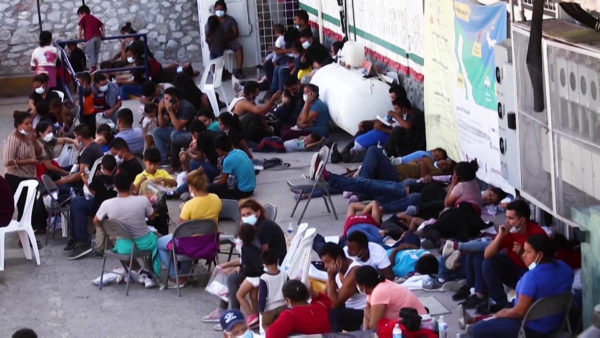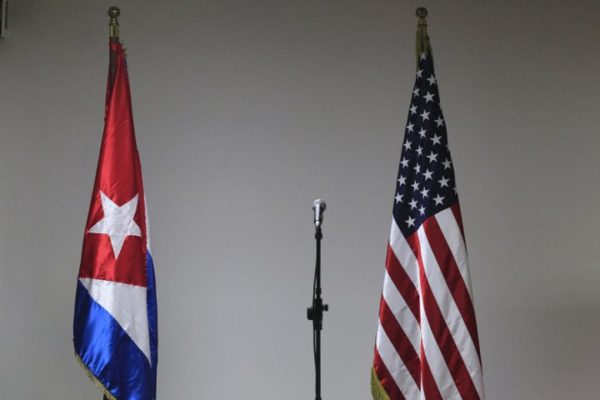The Mounting Cuba-US Immigration Dilemma

The Cuban government complains that in recent years the US stopped granting 60,000-80,000 visas based on their negotiations.
By Luis Brizuela (IPS)
HAVANA TIMES – According to Cuban Dayana Sanchez, US consular services reopening in Havana would mean that the paperwork needed for her and her three children to reunite with the father of her children, living in the US, would be sped up.
“We began our application process for family reunification in December 2018. While the case has already been approved, the interview continues to be postponed,” Sanchez explained over the phone to IPS, from the eastern Cuban city of Holguin.
She thinks “we could have our interviews in less than six months, but we have to wait for an appointment to become available in Guyana, unfortunately, not to mention travel costs, delays, and additional risks now because of COVID-19.”
Statistics from the US government reveal that 100,000 immigration and family reunification applications from Cubans are still pending, ever since Washington closed its Consulate in Havana.
The mysterious and never confirmed sonic attacks, reported publicly in August 2017 for the first time, was used by president Donald Trump (Jan 2017 – Jan 2021), to justify the withdrawal of most of US diplomatic personnel in Cuba.
The Republican government decreed a reduction in the validity of US visas for Cubans, and the need to travel to Guyana to get their visas from its embassy in Georgetown, a process that prolongs this application and makes it much more expensive, plus it does not guarantee a visa.
In immigration agreements signed in 1995, after the rafter crisis, Washington committed to granting at least 20,000 visas per year in order to facilitate legal, safe and organized immigration from this Caribbean island, which is only separated from the US by the Florida Strait.
The Cuban government complains that their neighbor in the North stopped granting what should have been 60,000-80,000 visas in recent years.
After the July 11th protests on the island, president Biden announced that he would look at the possibility of increasing US diplomatic personnel in Cuba.
“Immediately picking up on immigration agreements, adjusting their implementation to the challenges presented by the pandemic, would be the best and most rational position from a US foreign policy view,” Cuban political expert Arturo Lopez-Levy analyzed when talking to IPS.
“Sadly, everything seems to indicate that the Biden Administration has adopted a short-term ideological view that… seems to prefer inactivity, waiting for the sanctions inherited from Trump to turn the pandemic into a problem the Cuban government can’t solve,” said the Assistant Professor of Politics and International Relations at Holy Names University, in California, US.

The ghost of a new exodus
Sociologists consulted by IPS mention that a percentage of the Cuban population, mostly young people, aspire to leave the country for a while or for good, to seek better opportunities in other places.
In spite of this being a global phenomenon, they say that it is nuanced by other specific factors such as the slow implementation of reforms that sought to modernize the country (since 2011) and leave behind the crisis it has been suffering since the early 1990s.
On top of this, there’s the US embargo that has been in force since 1962, and its sanctions were amplified during the Trump administration, which negatively impacted economic growth in Cuba.
Statistics from the US Coast Guard reveal an increase in the number of Cubans who have taken to the sea in improvised boats trying to reach the neighboring country, which is only separated by the 90 nautical miles (167 kms) of the Florida Strait.
In the 2021 US tax year (October 1st 2020 – 30th September 2021), the US Coast Guard intercepted almost 600 Cubans, compared to 313 in 2019 and 49 last year.
Days before leaving the White House, in January 2017, former US president Barack Obama (2009-2017) revoked the “Wet-foot/Dry-foot” policy, which guaranteed residency for Cuban citizens as soon as they set foot on US soil.
After the July 11th protests, US officials and politicians have warned of the possibility of another exodus from Cuba.
On July 12th, US Secretary of the Department of Homeland Security, Alejandro Mayorkas, stressed that “any migrant intercepted at sea, regardless of their nationality, will not be permitted to enter the United States.” Meanwhile, Senator Rubio warned that a mass influx of migrants “will be seen and treated as a hostile action against the US.”
In situations of mega crisis such as in 1980 and 1994, boats left the island for the US with approximately 125,000 and 35,000 Cubans respectively, in just a matter of weeks, which some researchers consider an escape valve for citizens unhappy with the socialist political system in force.
Miguel Diaz-Canel’s government has said that it will uphold its commitment with migration agreements that aim to prevent irregular migration, preventing illegal departures that put human lives in danger and to fight against violent acts and crimes linked to human trafficking and migrant trafficking.
According to political expert Esteban Morales, the possible increase in US diplomatic personnel in Havana would be a sign that “Biden believes that more pressure needs to be put on Cuba, and he needs to be closer to the Cuban domestic situation so as to take better advantage of it.”
Morales explained to IPS that the president’s steps in immigration issues relating to the island seem to be guided by “the idea of taking advantage of a difficult situation, in which he believes Cuba is sinking,” so he needs to see “how he will do what he has promised, in a situation where he is only trying to win more time.”

Land route
News platforms report an increase in the number of Cuban migrants (among other nationalities) traveling to the south US via the dangerous Darien Gap, on the Colombian border with Panama.
According to testimonies, many migrants are victims of drug trafficking and human trafficking networks, sexual abuse, child labor, labor exploitation, and other violations, or they perish because of harsh environmental conditions.
These testimonies also say that many of them have been in South America for months or years, but that they have lost their jobs due to the pandemic and this has forced them to embark on the land route to the North in search of better opportunities.
The Mexican Commission for Refugee Assistance reported that over 5000 Cubans had sought asylum from the Mexican government between January and June, making them the third nationality with the most refugee applications, after Honduras and Haiti.
For their part, US Border Control has counted over 22,000 Cubans who have tried to cross the US-Mexico border illegally, three months before the end of the 2021 fiscal year.
These figures mark an important increase from the 13,000 Cubans they stopped the previous year.
The Cuban government believes the Cuban Adjustment Act, which dates back to 1966, stimulates illegal immigration as it makes Cubans eligible for permanent residency after a year and one day of being on US soil.
Since 2013, updates to Cuban immigration law eliminated the Exit Permit – a document that was needed for travel abroad up until then – and extended temporary stays abroad from 11 to 24 months without losing rights on the island, among other measures.
In 2019, statistics from the International Organization for Migration revealed that the Cuban diaspora grew to 1,558,312 people in 120 countries.
This figure is the equivalent of 13.6% of the 11.2 million inhabitants living in this Caribbean archipelago.
Meanwhile, the National Survey of Migration, published in January 2019, revealed that 75% of Cubans living abroad temporarily and 88% of Cubans living abroad for good, are aged between 15-49.






The Cuban government should retaliate against the draconian sanctions and embargo by unleashing another mass exodus. That way the US would be forced to negotiate with the Cuban government, just like during 1980 and 1994. I don’t like seeing people risk their lives and hopefully there wouldn’t be any casualties. Yet this might be the only way to get rid of the failed policy by the US against Cuba, since Biden insists on listening to Bob Menendez and other creatures in Congress, instead of going back to Obama’s policy.
In a perverted way, blocking Cuban immigration serves the Castro dictatorship’s purposes. By frustrating young people’s desire to leave the country, the US sets itself up as the boogeyman in the eyes of the youngest generation.
Tom Miller is correct in expressing sympathy for the people of Cuba and referring to the 400 years (1478-1898) of Spanish colonial rule – which was followed by prolonged interference and occupation (Taft appointed himself Governor of Cuba) by the US. But he ignores the sixty two years of communist repression under the Castro regime. It is little wonder that for Cubans, the concept of liberty and freedom of the individual and thought, remains but a dream.
Continued U.S. hard line policy toward Cuba will backlash in terms of an increase in economic refugees, increased suffering for the Cuban people and the ongoing image of the most powerful nation in the world bullying a small neighbor which refuses to do its bidding after having experienced over 500 years of colonial rule and U.S. imperialism. Everyone in Cuba wishes an immediate lifting of the U.S. embargo, but regretfully, they do not vote in Florida.